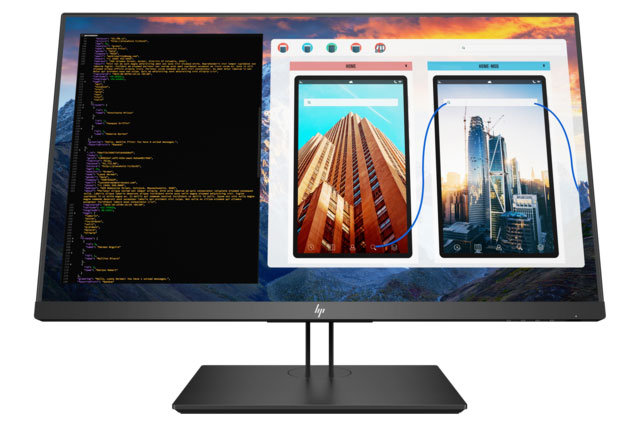Choosing a monitor for photo editing is partly about size, but it’s also about color accuracy, brightness, and contrast, which are all vital elements when it comes to viewing and editing photos. Whether you’re a photography student, a professional, or are just dabbling in the hobby, using the best monitor for the job will enable you to edit your photographs to an optimal standard. We’ve picked the very best monitors for photo work that we’ve found during our reviews, starting with the photo-dedicated BenQ SW271.
At a glance
- BenQ SW271
- BenQ PD3200U
- MSI Prestige PS341WU
- HP Z27
- Eizo ColorEdge CS2731
- Acer ConceptD CM2 Series
- Acer Predator XB253Q
BenQ SW271

Considering how much we loved the older SW2700PT, it should be no surprise that the BenQ SW271 tops our list of the best photo editing monitors out there. This 27-inch IPS display ticks just about every box you could hope for: 4K resolution, HDR, and great color support. BenQ claims it can handle 100% of the sRGB gamut and 99% for Adobe RGB, too. And at a brightness of up to 350 nits, it should be bright enough for most users’ tastes.
Thanks to being an IPS panel, it enjoys a nearly 180-degree viewing angle horizontally and vertically, and it has a native contrast of 1,000:1 for deep blacks and stark whites. It’s not the biggest display out there, but 27 inches is a good sweet spot for pixel density and gives you enough room to appreciate the detail offered by the ultra-HD resolution and HDR support.
With a whole host of connection options, from USB-C to HDMI 2.0 and DisplayPort 1.4, you can have your pick of how it connects to your system. The built-in calibration tools will make sure that it looks the part the first time you turn it on. At around $1,000, the BenQ SW271 is not the most expensive monitor in the world, but if you’re happy to sacrifice resolution to save a little, the SW2700PT — with its QHD display — is still a solid choice.
BenQ PD3200U

Another great photo editing display is the BenQ PD3200U, which, at $700, is one of the more affordable options out there — especially considering its feature set. At 32 inches diagonally with a 4K resolution, you get a lot of screen real estate for your money, making it easier to pick out individual details on your photos. It also has near-perfect color accuracy, which is easily one of the most important features of any monitor competing in this space.
With a brightness of 350 nits and a native contrast ratio of 1,000:1 (we found it more like 670:1 in our testing), the BenQ PD3200U has a lot going for it. The only real area we found it let us down in was color gamut support. Although BenQ claims 100% coverage for the sRGB and Rec.709 gamuts, when it came to AdobeRGB, we found it only managed 75%, falling behind the competition.
Still, with everything else going for this display, it’s definitely one worth considering for your next upgrade.
MSI Prestige PS341WU

If you’re looking for an ultrawide to facilitate your photo work, this 34-inch, 5K Prestige model is designed specifically for top-notch color results. It offers 16.7-million color support (98% of the DCI-P3 color gamut) that’s precalibrated for best results, along with MSI’s Creator OSD software for micromanaging screen settings to meet your unique standards whenever necessary.
Picture-in-picture and picture-by-picture modes are both offered for comparing before and after images, and the Nano-IPS panel includes an anti-glare coating so reflections won’t be as troublesome. On the back, you’ll find ports for HDMI 2.0, DisplayPort 1.4, and USB-C to manage your connections. And while the MSI Prestige PS341WU’s screen is extra large, it’s still possible to tilt, swivel, or mount it to get just the angle you need.
HP Z27

HP’s Z27 monitor has been one of our favorite 4K displays for some time, and with good reason. Not only does it have a decent form factor at 27 inches with a solid frame, but it has
It features excellent color accuracy and is backed by HP’s Zero Bright Dots guarantee, so if there are any problems with your screen post-purchase, HP is more than happy to sort it out for you. It’s also powered by just a single USB-C cable, so there’s no need for additional power connectors, making for a sleek look for your desktop space. Other options, if you prefer to use them, include DisplayPort 1.2, mini DisplayPort 1.2, and HDMI 2.0.
Despite all its high-end features, the HP Z27 is a very affordable 4K professional display, too. Even when not on sale, it’s not much north of $500.
Eizo ColorEdge CS2731

Eizo’s 27-inch ColorEdge may not have the slim bezels of some of our other picks, but it’s designed for working with color-focused editing and knows its job thoroughly. In addition to the 2560 x 1440 resolution, the monitor offers a color gamut spanning 99% of the Adobe RGB range for easy conversion of RAW files to AdobeRGB. It also sports a 16-bit LUT and 10-bit color depth rating.
The model is factory-calibrated but includes support for ColorNavigator software for professionals to make tweaks on their own as well. We also appreciate the versatile stand, which is easy to reposition and offers thorough options for adjusting height, tilt, and portrait display, and it even has a quick-release feature so you can temporarily remove the display if necessary. There’s also a loop in the back of the stand for quick cord management.
Connections for the ColorEdge CS2731 are primarily managed through USB-C, so you’ll want to make sure you have compatible devices., although DisplayPort, HDMI, and even DVI-D are also included. If something goes wrong, there’s also a five-year manufacturer warranty.
Acer ConceptD CM2 Series

Acer’s ConceptD CM2 monitors are specifically made with color accuracy in mind, and this model definitely delivers: Its FHD, 24-inch panel offers up to 350 nits of brightness (you can actually push a little higher if you want) and a static contrast ratio of around 1000:1. The color coverage is also deeply impressive, covering 100% of sRGB, 99% of AdobeRGB, and 97% of DCI-P3, and color accuracy is at the top of what the monitor market can currently achieve.
We also really like the unique design of this model, which includes that interesting round, wood-patterned base. It’s a nice little space to put your devices while you are transferring photos or charging them (or put a zen garden there, we won’t judge), but don’t worry — the monitor can also tilt, rotate, change height, go vertical, or be attached with a VESA mount, so you have plenty of options.
Ports for the Acer ConceptD CM2 Series include two HDMI and a DisplayPort, plus a USB-A 3.0 hub — although it’s a little disappointing not to see USB-C on this monitor for the latest accessories.
Read our full review of the Acer ConceptD CM2 Series
Acer Predator XB253Q
The Acer Predator line is popularly known as a series of gaming monitors — but that doesn’t mean that this model can’t handle professional image work as well while also being a great choice for gaming when you have some downtime.
The 24-inch monitor offers full HD resolution on an IPS screen that supports G-Sync for extra compatibility with Nvidia graphics cards, a refresh all the way up to an amazing 280Hz, and a response time that can reach 0.5ms. So far, so great for gaming. But this Predator also offers a color gamut that spans 99% of the sRGB space and is a top choice for making sure both photos and games look their best. Display HDR 400 is also supported, and you can switch to game modes to help improve performance while having fun. There’s even an RGB light bar to play with!
Ports for the Acer Predator XB253Q include DisplayPort, two HDMI 2.0 ports, and four USB-A 3.0 ports, plus a design with a gap in the stand for cable management to keep everything looking great!
Editors' Recommendations
- These are the 10 best gaming PCs I’d recommend to anyone
- The best laptop brands for 2024
- 9 best 2-in-1 laptops in 2024: tested and reviewed
- The best processor for video editing in 2024 across all budgets
- Best 14-inch laptops for 2024: tested and reviewed





